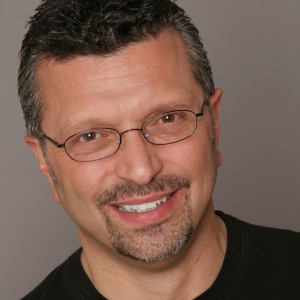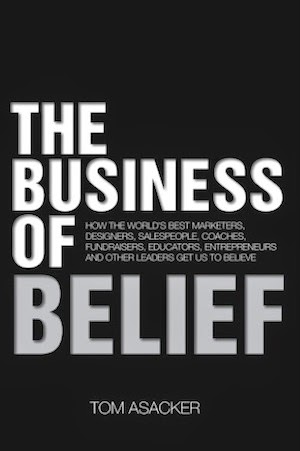Where do your beliefs come from? How can you influence customers, colleagues and other stakeholders to follow your beliefs?
Beliefs cover every dimension of our lives. An integral part of who we are, they drive our feelings, thoughts, actions and goals. To be effective leaders and influencers, we must understand what beliefs are, and how we can influence the beliefs of others.
This is where Tom Asacker’s The Business of Belief comes in. A slim 120 odd pages, the part management part self-help book is filled with anecdotes on leadership, human psychology, religion and philosophy.
Subtitled “How the World’s best marketers, designers, salespeople, coaches, fundraisers, educators, entrepreneurs and other leaders get us to belief”, it is reinforced by brief case studies from history to contemporary culture. Featured personalities and organisations include leading influencers Gautama Buddha, Apple, Joshua Bell, Bob Dylan, NYPD Blue, Mother Teresa and Lao-Tzu.
To unpack the book further, let me give you a helicopter view of its three parts.
What belief truly is
The first and heftiest section tries to define what we understand about belief itself.
We choose what we believe in. Often, these beliefs are the assumptions we make about all of life’s decisions – from the most trivial and mundane to significant “milestone” decisions concerning religions, marriages, and other important life choices.
Constructed in our minds, beliefs are reinforced by our circumstances, mood and personality.
Believing is also feeling. Our beliefs make everything surrounding us appear real, convincing, stable, orderly and predictable.
Unfortunately, there is an inherent quirk in our emotional and psychological wiring. Often, what we perceive to be real may sometimes be an illusion.
Why is this so?
Well, our minds are hardwired to be biased. They compel us to see patterns and make meaning of things, even when they are not there.
We select and modify inputs to make our own subjective sense of things. Indeed, our individual mythologies and comfortable, prefabricated interpretations and opinions shape our beliefs.
Often, these patterns take the form of stories. Stories that are heard, read, or experienced inform our inner lives.
We live in our stories and live according to them. Our evolving life stories often reinforces our world view. These biases help us to navigate a demanding and complex world, keep our personal narratives meaningful and consistent, and engender acceptance and approval of the people around us.
Influencing the beliefs of others
In this section, we are taught how we can influence people’s beliefs and behaviours. The trick here is to not to force or manipulate them to do so, but to understand their perspectives, embrace their desires and beliefs, and flow from there.
To influence others to design and embrace new beliefs, you can adopt the following:
1) Make your followers feel comfortable. Acknowledge their feelings, provide them with ample freedom, and guide them to move in the right direction. At the same time, be consistent, familiar and safe.
2) Paint a beautiful picture of possibility. Help them anticipate a better experience and better life. Quoting John Quincy Adams: “If your actions inspire others to dream more, learn more, do more and become more, you are a leader.”
3) Make them feel that they are at the centre of things (even if they aren’t). Connect your voyage with their desires and choices.
4) Make it easy by being focused, reducing distractions, and simplifying the process. Apple is naturally the shining example of “easy”.
5) Nudge them to cross the bridge by creating experiences. Use repetition to make their actions appear familiar and safe.
6) Celebrate milestones. Make your group’s progress visible by validating accomplishments and rewarding them.
7) Exude passion, not necessarily in the manner of charismatic leaders like John F. Kennedy or Martin Luther King, Jr., but by being open about your values and convictions.
8) Nuance and control your impulses. Learn how you can hold your tongue, soften your facial expressions, and listen with empathy. Remember that great leaders “skillfully walk that tightrope by strategically controlling their impulses”.
9) Hide the how. Do this by bringing mental images to life, elevating their energy, and instigating change while hiding the boring details and inner workings of the journey.
Experiencing the power of personal beliefs
This final section relates to how we can individually experience the power of beliefs.
Here, we are taught to slow down, be more conscious of our choices, ignore trying to search and verify everything with Google, and choose to follow our heart.
The idea of “following your heart” was nicely exemplified by a vignette about Vince Gilligan. In the book, we learned how Gilligan’s acclaimed TV series “Breaking Bad” succeeded despite being similar to another TV series “Weeds”. By following his heart, he went ahead to pitch the idea of “Breaking Bad” to network executives and chose not to listen to naysayers.
Last but not least, we are told to “flip the lid”. This entails changing our default mode from “perception-cognition-belief-decision” to “decision-belief-cognition-perception”.
In other words, we should make the decision first, allow that choice to direct our thoughts and inform our instincts, and thereafter allow it to influence our feelings and perceptions.
Let me end with a couple of “quotable quotes” from the book.
“What we believe is what we desire, and what we desire is ultimately what we do. It’s the human condition.”
“Change your behaviour and your behavior will change your mind.”
“Comfort is an illusion; a fantasy that imagines freedom from pain and suffering if only we stay still and avoid change.”

Tom Asacker (courtesy of Actionable Books)


